Mastering the art of making okonomiyaki, Osaka’s signature savory pancake, can be a rewarding experience. By joining a cooking class, you’ll dive into the intricacies of this beloved dish. From crafting the perfect batter to grilling techniques, you’ll uncover the secrets to recreating the iconic flavors at home. Get ready to impress your friends and family with your newfound okonomiyaki expertise.
Good To Know
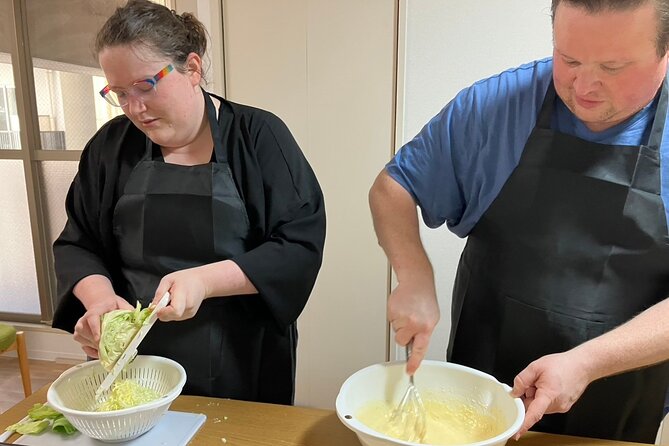
- Learn the proper batter consistency and technique for achieving the signature fluffy texture of authentic Osaka-style okonomiyaki.
- Discover the essential ingredients, including flour, dashi stock, eggs, and grated nagaimo, and how to combine them to create the base.
- Explore the key role of shredded cabbage and scallions in providing crunch, moisture, and freshness to the savory pancake.
- Understand the versatility of okonomiyaki by trying different protein fillings, such as thinly sliced pork belly, shrimp, or squid.
- Master the cooking method, including the proper way to assemble and cook the okonomiyaki on a griddle or cast-iron skillet.
What Is Okonomiyaki?
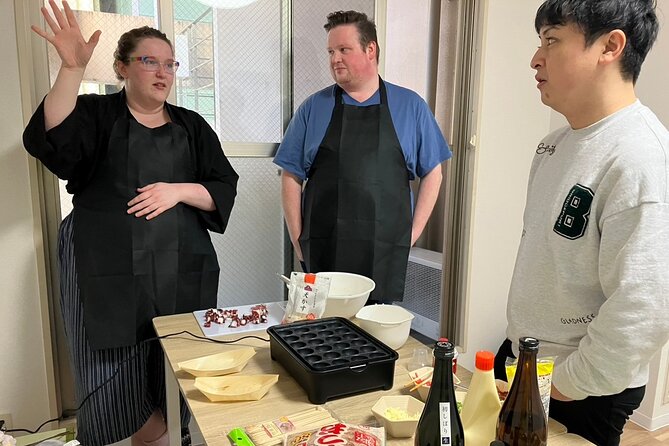
Okonomiyaki is a savory Japanese pancake that originates from Osaka.
It’s made with a batter containing shredded cabbage, scallions, and various protein-rich ingredients like pork, shrimp, or octopus.
The name "okonomiyaki" comes from the Japanese words "okonomi," meaning "what you like" or "how you want it," and "yaki," meaning "grilled" or "cooked."
This versatile dish allows for endless customization, making it a popular choice for home cooks and street foodies alike.
Okonomiyaki is typically grilled on a flat-top or cast-iron skillet, then topped with savory sauces, dried seaweed, and paper-thin slices of pickled ginger.
Find more activities and experiences we've covered in Osaka.
Ingredients for Okonomiyaki
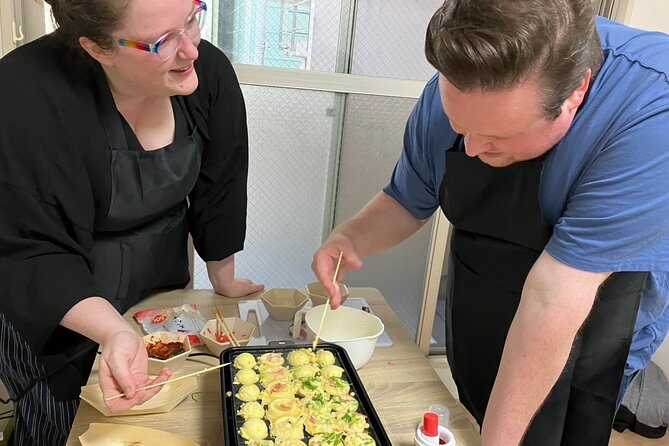
The main ingredients for this classic Japanese savory pancake include a flour-based batter, shredded cabbage, scallions, and various proteins like pork belly, shrimp, or octopus.
The batter is a simple mixture of flour, dashi stock, eggs, and grated nagaimo (a type of yam) which gives it a unique texture. Shredded cabbage provides crunch and moisture, while scallions add freshness.
Popular protein choices include thinly sliced pork belly, shrimp, squid, or octopus.
Okonomiyaki is also often topped with a tangy Worcestershire-based sauce, Japanese mayonnaise, and dried bonito flakes or pickled ginger.
How to Make the Okonomiyaki Batter
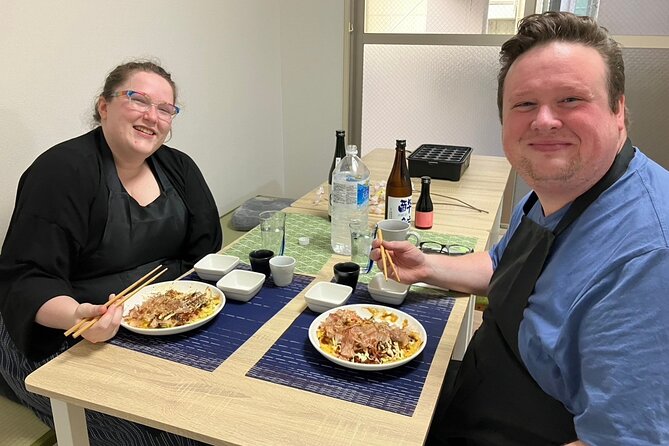
Although the okonomiyaki batter may seem straightforward, crafting the perfect consistency is key to achieving the desired texture.
Start by mixing the flour, eggs, dashi stock, and soy sauce in a large bowl until well combined. The batter should be thick enough to coat the back of a spoon, but not too dense.
Adjust the consistency by adding more dashi or flour as needed. Be mindful not to overmix, as this can result in a tough, chewy texture.
With the right batter, you’ll be well on your way to creating authentic, fluffy okonomiyaki at home.
Preparing the Okonomiyaki Fillings
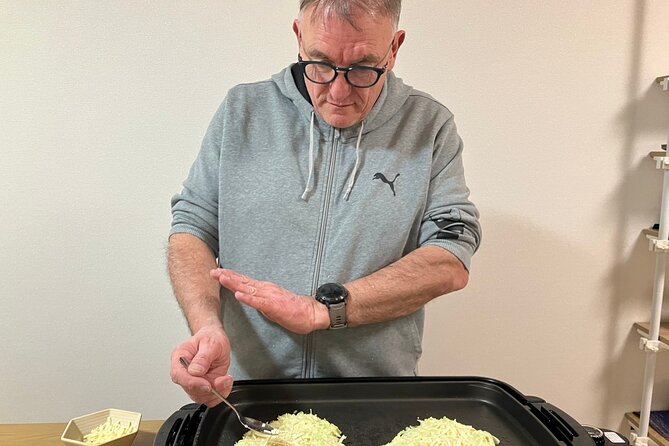
Gather the essential ingredients for the okonomiyaki fillings – shredded cabbage, sliced green onions, and any desired protein or vegetables. The key is to prepare all the fillings in advance so they’re ready to be added to the batter on the griddle.
| Filling | Amount |
|---|---|
| Cabbage | 2 cups, shredded |
| Green Onions | 1/2 cup, sliced |
| Pork or Seafood | 1/2 cup, cooked and chopped |
| Pickled Ginger | 2 tablespoons, chopped |
| Tempura Bits | 1/4 cup |
With the fillings prepared, you can now focus on cooking the okonomiyaki batter on the griddle and adding the ingredients in layers for a traditional Osaka-style okonomiyaki.
Assembling and Cooking the Okonomiyaki
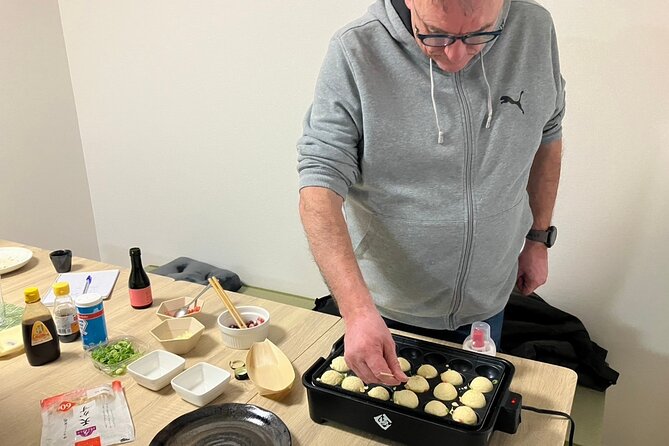
First, they’ll pour the okonomiyaki batter onto the hot griddle, evenly spreading it out into a round shape.
Next, they’ll add the fillings, such as cabbage, pork, shrimp, or whatever the desired ingredients are.
The okonomiyaki is then cooked until the bottom is golden brown, about 3-4 minutes.
Gently flip it over and cook the other side until fully cooked through, another 3-4 minutes.
Once done, they’ll transfer the okonomiyaki to a plate and top it with the special okonomiyaki sauce, Japanese mayonnaise, bonito flakes, and pickled ginger, if desired.
Then, it’s time to enjoy the savory pancake creation.
- Private Car Full Day Tour of Osaka Temples, Gardens and Kofun Tombs
- Private Arrival Transfer From Kansai Airport to Osaka City
- Osaka Nightlife Tour and Bar Hop
- Kyoto Private Tour (Shore Excursion Available From Osaka or Kobe Port)
- Heart-Warming Japanese in Home Cooking Lesson With a Local Mother in Osaka
- Retro Osaka Street Food Tour: Shinsekai
Toppings and Sauces for Okonomiyaki
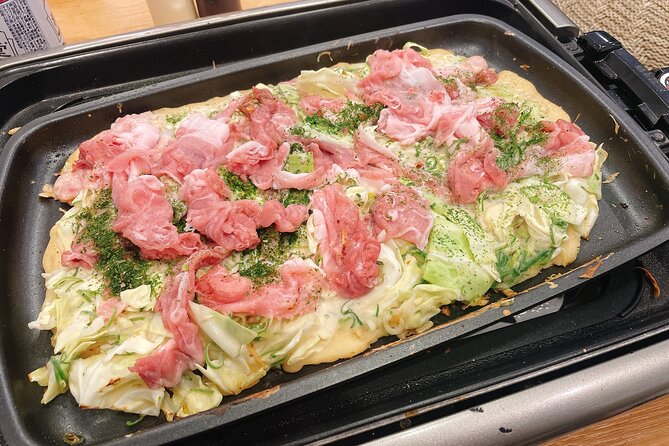
After the okonomiyaki is cooked, it’s time to add the toppings and sauces that truly make this savory pancake come alive.
The classic toppings include pickled ginger, dried seaweed, and Japanese mayonnaise. Drizzle the okonomiyaki with the signature okonomiyaki sauce, a sweet and tangy sauce made from Worcestershire, soy sauce, and sugar.
Top with a generous sprinkle of dried bonito flakes, which add a savory umami flavor. For a unique twist, try adding a raw egg yolk to the center of the pancake just before serving.
These toppings and sauces are what transform okonomiyaki into an unforgettable Japanese street food delight.
Making Takoyaki at Home
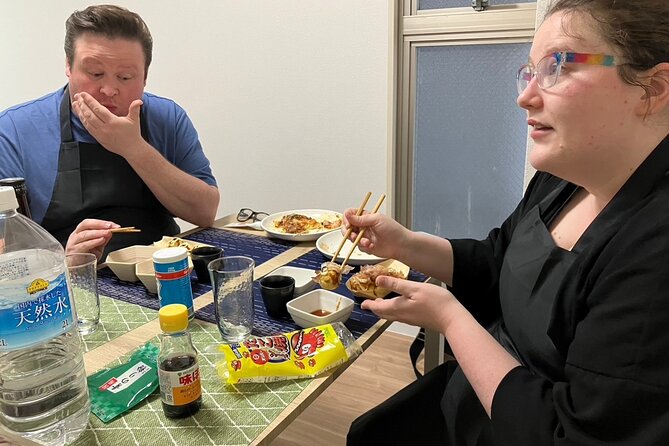
Although takoyaki may seem intimidating to make at home, with the right equipment and a little practice, anyone can master this delightful Osaka street food.
The key is having a proper takoyaki pan with round molded indents. Fill the indents with batter, then add diced octopus, green onions, and ginger.
Rotate the balls as they cook, creating their signature round shape. Top with takoyaki sauce, Japanese mayonnaise, bonito flakes, and aonori seaweed.
Serve hot and enjoy the crispy exterior and soft, savory interior of homemade takoyaki.
Tips for Successful Okonomiyaki and Takoyaki
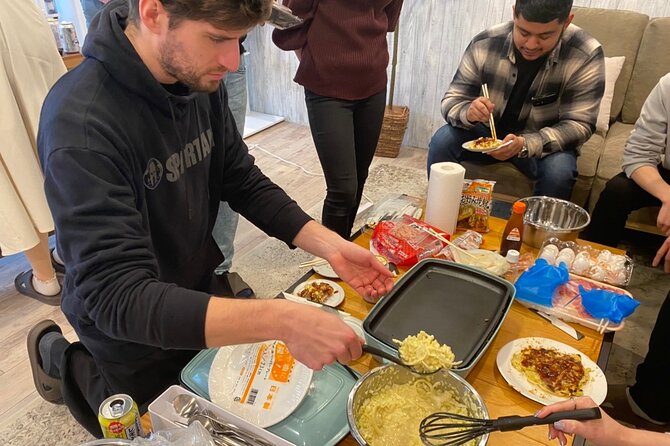
To make delicious okonomiyaki and takoyaki at home, there are a few key tips to keep in mind.
Here are four essential tips:
Use the right batter consistency. The batter should be thick enough to hold the ingredients together, but not too dense.
Cook at the right temperature. Okonomiyaki and takoyaki require high heat to create that signature crispy exterior.
Experiment with fillings. Customize your dishes with a variety of proteins, vegetables, and sauces to find your perfect flavor combination.
Master the cooking technique. Carefully manage the flipping and rotating of the pancakes and balls for even cooking.
Frequently Asked Questions
What Is the Class Duration?
The class duration is not explicitly stated in the provided information. However, typical cooking classes of this nature generally last 1-2 hours, allowing ample time for preparation, cooking, and enjoying the dishes.
Can I Request a Private Class?
Yes, travelers can request a private class for the Osaka Okonomiyaki Cooking Class. The maximum group size is 8 participants, so a private class can be arranged for smaller groups or individual travelers. Confirmations are subject to availability.
Do I Need to Bring My Own Cooking Equipment?
No, you don’t need to bring your own cooking equipment. The class provides all the necessary tools, including kitchen tools, aprons, and disposable plastic gloves. All you need to bring is your enthusiasm for learning how to make authentic Osaka-style okonomiyaki and takoyaki.
Are There Any Dietary Restrictions Accommodated?
The cooking class accommodates various dietary restrictions upon request. Travelers with specific dietary needs can notify the instructors beforehand, and the class will be adapted to ensure an inclusive and enjoyable experience for all participants.
How Do I Get to the Class Location?
To get to the class location, take public transportation as it’s accessible via public transit. The class is held at ディアコート船場, a wheelchair-accessible building on the 3rd floor (room #303).
The Sum Up
Cooking okonomiyaki at home can be a fun and delicious experience. With the right ingredients and techniques, you can create authentic Japanese savory pancakes that are sure to impress. Remember to experiment with fillings and toppings to find your perfect combination. Mastering okonomiyaki and takoyaki will allow you to enjoy these beloved Japanese street foods in the comfort of your own kitchen.
More Tour Reviews in Osaka
Looking for something different? Other Osaka activities we've written about
- Osaka Kansai Airport to Kanazawa City Private Transfer
- Deep Food Tour & Bar Hopping in Temma, Osaka
- Tea Ceremony Experience in Osaka
- Osaka: Private Food Tour & Bar Hopping in Namba
- Kobe Night View Mt Rokko Kitano Ijinkan Arima Onsen Day Trip
- 2 Hours Karaoke Room With Set Menu and Unlimited Drinks in Osaka
- Osaka Kuromon Market With a Chef!
- 1 Hour Food Tour at the Kuromon Market in Osaka
- Tea Ceremony and Calligraphy Experiences in Osaka
- Kyoto/Osaka: Kyoto and Nara Customized Private Guided Tour
- Osaka 1-Day Private Tour – Osaka Castle, Shinsekai, Dotonbori
- Arashiyama Autumn Leaves & Sanzen-In Temple Tour From Osaka/Kyoto
